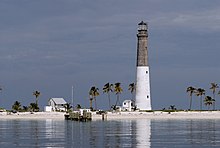Loggerhead Key
Census County Division | Lower Keys | |
| Demographics | ||
|---|---|---|
| Population |
| |
| Additional information | ||
UTC-4:00 ) | ||


Loggerhead Key is an uninhabited
Climate
Loggerhead Key has a tropical savannah climate (Aw). Summers are long, hot and year round. The rainy season lasts from June to October with light rainfall when compared to the rest of Florida. Loggerhead Key is likely the driest place in Florida with the lowest amount of precipitation inches and precipitation days, being far from the Florida mainland where afternoon thunderstorms form with ease over the land.
| Climate data for Loggerhead Key | |||||||||||||
|---|---|---|---|---|---|---|---|---|---|---|---|---|---|
| Month | Jan | Feb | Mar | Apr | May | Jun | Jul | Aug | Sep | Oct | Nov | Dec | Year |
| Mean daily maximum °F (°C) | 74 (23) |
76 (24) |
78 (26) |
83 (28) |
86 (30) |
90 (32) |
91 (33) |
92 (33) |
90 (32) |
85 (29) |
79 (26) |
76 (24) |
83 (28) |
| Daily mean °F (°C) | 69.5 (20.8) |
70.5 (21.4) |
72.5 (22.5) |
77 (25) |
80 (27) |
83.5 (28.6) |
84.5 (29.2) |
85.5 (29.7) |
83.5 (28.6) |
80 (27) |
74.5 (23.6) |
71.5 (21.9) |
77.7 (25.4) |
| Mean daily minimum °F (°C) | 65 (18) |
65 (18) |
67 (19) |
71 (22) |
74 (23) |
77 (25) |
78 (26) |
79 (26) |
77 (25) |
75 (24) |
70 (21) |
67 (19) |
72 (22) |
| Average precipitation inches (mm) | 2.7 (69) |
1.8 (46) |
2 (51) |
1.9 (48) |
1.9 (48) |
3.3 (84) |
2.8 (71) |
3.7 (94) |
6 (150) |
4.6 (120) |
1.9 (48) |
2.1 (53) |
34.7 (882) |
| Average precipitation days | 5 | 3 | 3 | 2 | 4 | 6 | 6 | 8 | 9 | 7 | 3 | 4 | 60 |
| [citation needed] | |||||||||||||
Etymology
Loggerhead Key is named after the loggerhead sea turtle, an endangered marine reptile and species of sea turtle with a cosmopolitan distribution throughout the world.[3]
Coral reefs
The Little Africa coral reef is located at Loggerhead Key.[4] The reef is home to various species of tropical fish, spiny lobster and several juvenile game fish.[4] Coral types include "various species of stony and gorgonian coral".[4]
Flora and fauna
The flora of Loggerhead Key includes mangrove, coconut palms, geiger trees, morning glory, sea lavender and cactus.[3] In the 1840s, the island was covered with white buttonwood trees, which were burned or cut down by island inhabitants.[6] Bay cedar existed on the island in the early 1900s.[6]
Fauna of Loggerhead Key includes sea turtles, which are monitored by park rangers with the Dry Tortugas National Park to document nesting and hatching rates.[7] The loggerhead sea turtle is also present on the island.[8] In August 2016, a National Park marine biologist stated that 113 loggerhead turtle nests existed on the island at that time.[8] This was the highest recorded nest rate compared previous years.[8]
The island also has brown pelicans.[7]
Former rhesus macaque habitat
In 1972, hundreds of rhesus macaque monkeys were brought from India to Loggerhead Key by Charles River Laboratories.[9][10] This was done to provide the monkeys a place to breed, to supply the animals for medical research laboratory experiments.[9][10] Around 1,322 of the monkeys existed on the island between 1987 and 1990.[10]
Dry Tortugas Light

The Dry Tortugas Light is a lighthouse located on Loggerhead Key.[4][11] It began operations in 1858 and was decommissioned in 2014.[7][12]
Carnegie Marine Biological Laboratory
The Carnegie Marine Biological Laboratory, also referred to as the Tortugas Laboratory, was a
References
- ^ "Loggerhead Key". Geographic Names Information System. United States Geological Survey, United States Department of the Interior. October 19, 1979. Retrieved October 18, 2017.
- ^ "Loggerhead Key High Point". Peakbagger.com.
- ^ a b c d e f g Block, Melissa (October 26, 2016). "Making Art Off The Grid: A Monthlong Residency At A Remote National Park". WLRN. Retrieved September 7, 2017.
- ^ a b c d e f g "Explore Loggerhead Key". Dry Tortugas National Park (U.S. National Park Service). August 28, 2015. Retrieved September 7, 2017.
- ISBN 978-1-62128-069-9. Retrieved September 7, 2017.
- ^ a b c d "Loggerhead Key Restoration". Dry Tortugas National Park (U.S. National Park Service). July 29, 2015. Retrieved September 7, 2017.
- ^ a b c Zach, Elizabeth (August 28, 2016). "West of Key West, an Under-the-Radar National Park". The New York Times. Retrieved September 7, 2017.
- ^ a b c Wadlow, Kevin (August 28, 2016). "It's a baby boom for sea turtles as nests pop up all over". miamiherald. Retrieved September 7, 2017.
- ^ ISBN 978-1-84306-210-3. Retrieved September 7, 2017.
- ^ ISBN 978-1-59726-331-3. Retrieved September 7, 2017.
- ISBN 978-1-57785-512-5. Retrieved September 7, 2017.
- ISBN 978-1-4262-0953-6. Retrieved September 7, 2017.
- ^ "Your dream job? 1 month on a deserted island as artist in residence". Miami Herald. June 19, 2016. Retrieved September 7, 2017.
- ^ ISBN 978-1-56164-203-8. Retrieved September 7, 2017.
- ^ ISBN 978-0-7872-9970-5. Retrieved September 7, 2017.
External links
 Media related to Loggerhead Key at Wikimedia Commons
Media related to Loggerhead Key at Wikimedia Commons- Loggerhead Key. National Park Service.
![]() This article incorporates public domain material from websites or documents of the National Park Service.
This article incorporates public domain material from websites or documents of the National Park Service.
